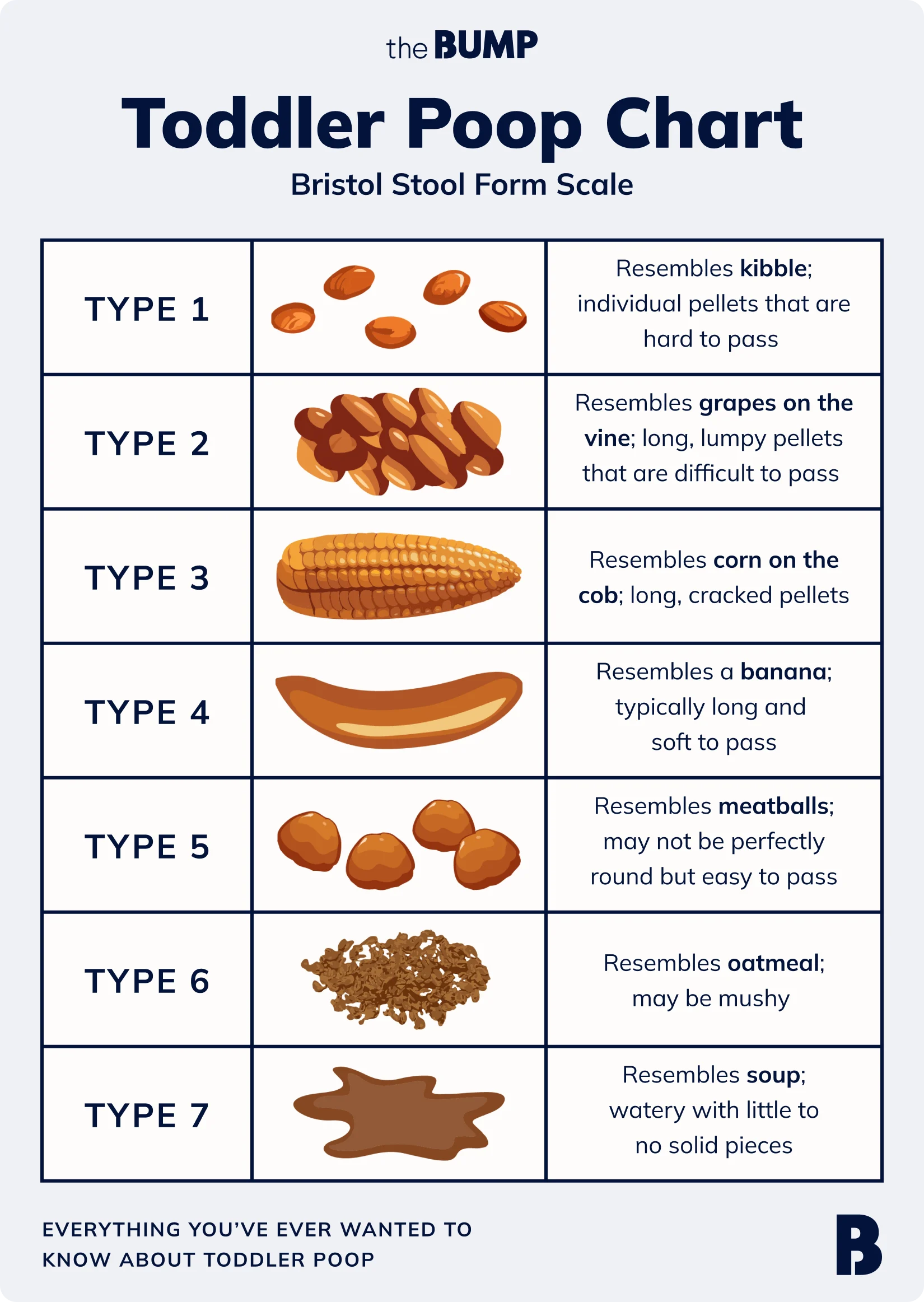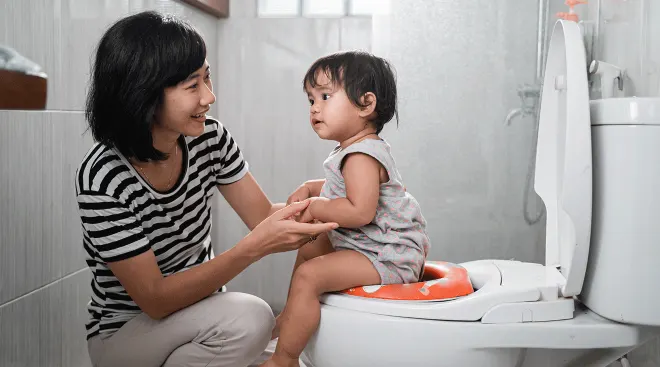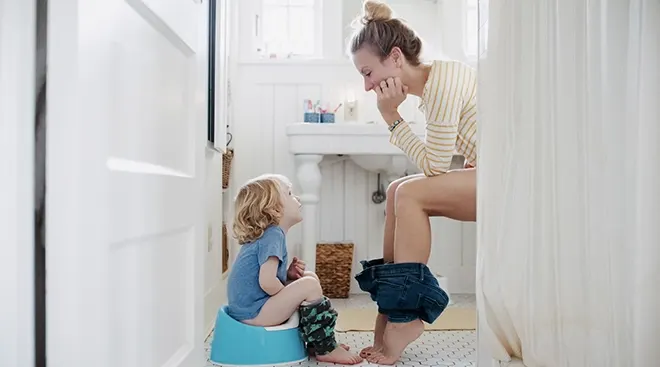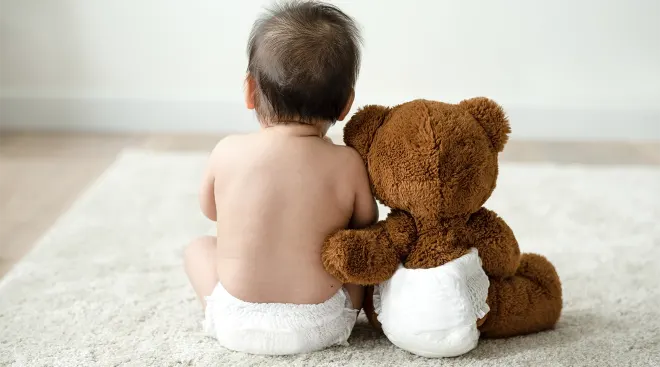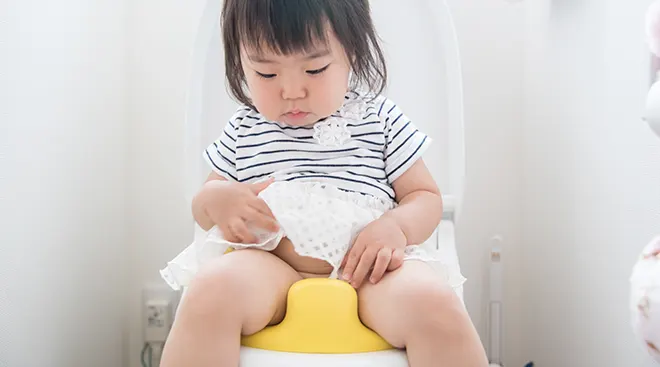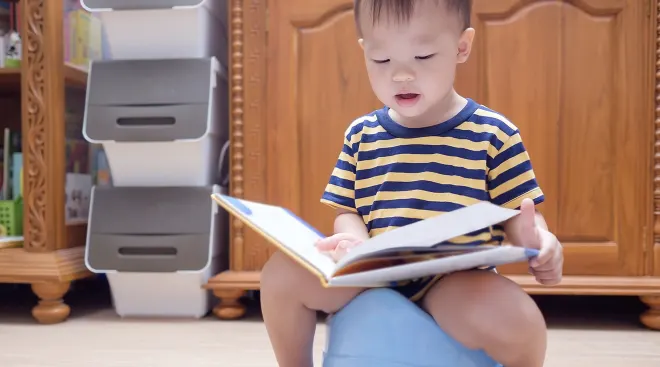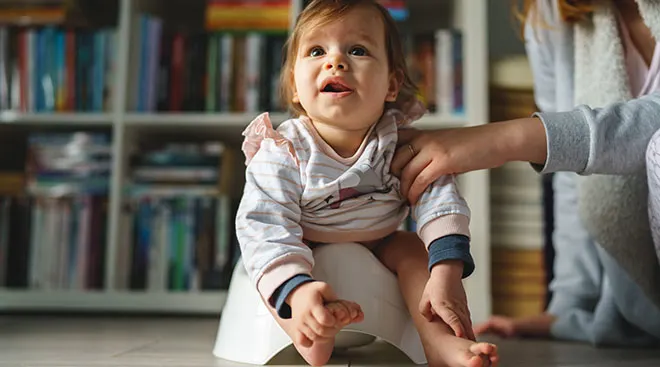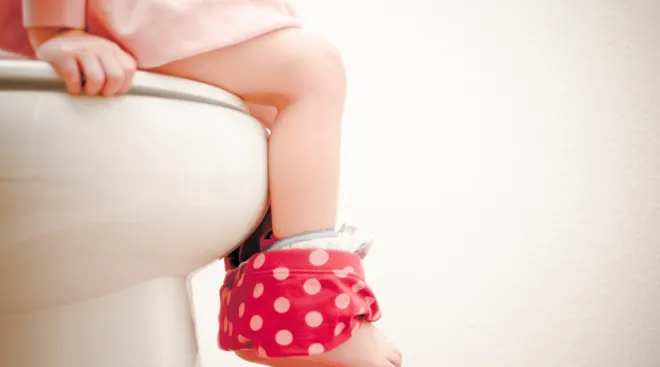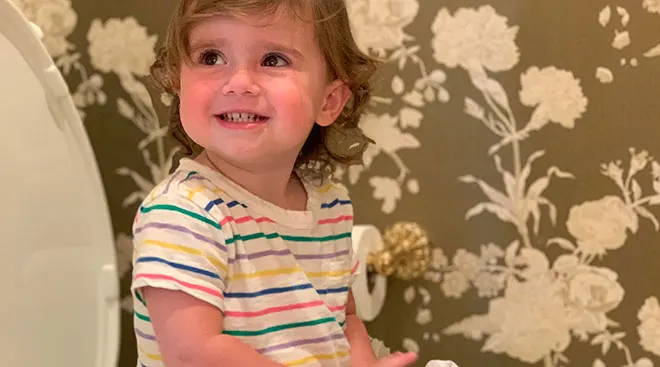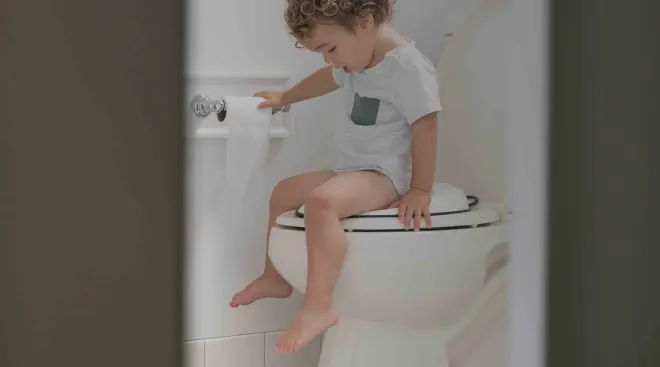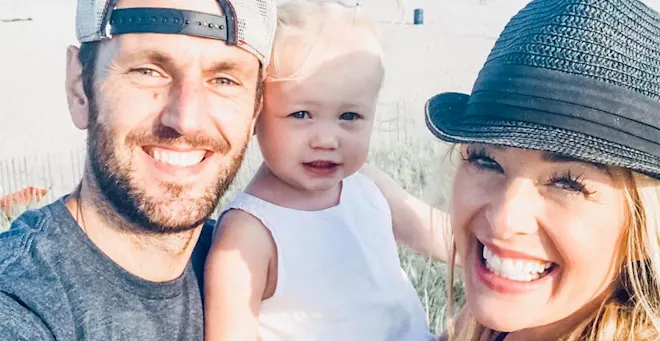Everything You’ve Ever Wanted to Know About Toddler Poop
No one thinks about toddler poop as much as toddler parents—except, of course, pediatric gastroenterologists. The topic consumes their every waking thought from 9 to 5—and with good reason. “Poop can tell us a lot about our health,” says Vivien Nguyen, MD, associate clinical professor at UCSF Benioff Children’s Hospital Oakland in California. “It isn’t something that’s usually discussed in day-to-day conversation, so it remains a bit mysterious, particularly in infants and children.” But considering how much toddler poop issues can complicate family life, from emergency stops during car rides to delays in school readiness, it really ought to be talked about more, says Bradford T. Miller, MD, MSc, a pediatric gastroenterologist at Riley Hospital for Children in Indianapolis, Indiana, and associate professor of pediatrics at Indiana University.
So let’s dish the scoop on toddler poop. How long can a toddler go without pooping? How can you help your toddler poop? And what should you do if your toddler’s poop is green, white or mucusy? Here, the answers to your most pressing toddler poop questions.
Ideally, children under 4 should have at least one soft-formed stool daily. And if not daily? “More than 90 percent of children go at least every other day,” estimates Miller. On average, though, the golden (er, brown) number is 1.6 times a day or 10.9 times weekly, according to a 2023 meta-analysis published in the Journal of Pediatrics, in which researchers looked at the frequency of pooping among children ages 0 to 4 living around the world.
However, as Nguyen adds, factors such as diet, activity level, fluid intake, willingness to use the bathroom and physiologic or psychosocial stressors can affect how often a child poops.
How long can a toddler go without pooping?
It’s not uncommon for toddlers to occasionally go a few days without pooping: “Stooling patterns are as unique as the children we treat,” Miller says. The tough part is that it’s cyclical: Trouble pooping can cause a child to unintentionally withhold stool, Nguyen warns. If they suddenly begin to poop less frequently than usual; pass small amounts of hard, pebbly or large caliber stool or go fewer than three times a week, they’d meet the clinical definition for “constipation” and could benefit from seeing their pediatrician.
When it comes to toddler poop, pediatric gastroenterologists have seen it all, But the most common issues they treat are, by far, constipation and diarrhea. For reference, normal toddler poop consistency should resemble types three or four on the Stanford Medicine’s Bristol Stool Form Scale, Nguyen says. “The longer poop spends in the colon, the more water is soaked-up from it, leading to harder, pebblier textures.” She adds that types one or two on the scale may indicate constipation and a need for more fiber or fluids, while types five through seven may indicate diarrhea.
- Constipation: According to Nguyen, there are two kinds of constipation: “Organic,” which has an identifiable cause (i.e., a digestive system disorder such as celiac) and “functional,” which can have any number of triggers, such as changes in diet or routine, potty training or illness. Regardless of the type, once a child becomes constipated, the backed-up stool can fill up, stretch out and impair the colon, making it even more difficult and painful to poop, she explains. But don’t worry, there are tons of effective ways to treat this toddler poop problem, from dietary changes to medication. Many doctors recommend simply sitting on the toilet for a few minutes after meals to prevent kids from withholding poop, which can both contribute to initial constipation and prolong it, Nguyen adds.
- Diarrhea: Marked by loose or watery poop with or without undigested food particles more than three times a day, diarrhea occurs when food and fluid move more quickly through a child’s intestinal tract, explains Nguyen. This can happen due to excessive fluid intake, a viral infection, bacterial infection, parasites, food intolerance, food allergies, celiac disease, inflammatory bowel disease or another reason. To help prevent diarrhea, Nguyen recommends a diet with healthy fats, which tend to slow digestion and allow more time for absorption of nutrients and fluid. And if any of the symptoms are prolonged or accompanied by a persistent fever, weight loss, vomiting, severe abdominal pain or signs of dehydration, reach out to your pediatrician.
Below a toddler poop chart that breaks down the consistency and type of stools your little one might be passing, as informed by the Bristol Stool Form Scale.
“Poop can come in any color of the rainbow (sometimes, even with glitter),” Nguyen says. Plus, stool colors in toddlers can vary based on a number of factors including diet, medication and personal microbiome, Miller adds.
That said, toddler poops are typically brown, yellow, tan or green. Poop that’s off this spectrum—such as white, black or red—could be a sign of illness. “It’s important to do a little detective work to sort out whether the colors are due to other dietary or environmental factors,” or disease, Nguyen says. Below, experts break down what certain toddler poop colors could mean:
- Green toddler poop: According to Seattle Children’s Hospital, green toddler poop could be caused by bile and be accompanied by diarrhea. But don’t worry about your kiddo’s green (and even dark green) poop—it’s usually nothing to worry about.
- White or light gray toddler poop: This may be a "sign of blocked bile ducts in the liver,” Nguyen says. However, too much dairy, as well as certain medications, may also cause lighter-colored stools, she adds.
- Yellow toddler poop: This is typically indicative of normal toddler poop, but in rare cases pale yellow poop may be a sign of liver disease, Seattle Children’s Hospital notes.
- Black toddler poop: Black stools could be a sign of blood in toddler poop and bleeding in the upper intestinal tract Nguyen explains. It can also be caused by ingestion of charcoal or foods high in pigment, like licorice, grape juice and blueberries.
- Red toddler poop: Red stools can be a sign of bleeding in the lower intestinal tract, per Nguyen. However, red toddler poop may also result from certain medications, like Amoxicillin and Cefdinir, or foods, including beet, tomatoes and Flamin’ Hot Cheetos. In fact, Seattle Children’s Hospital notes that 90 percent of red stools aren’t actually caused by blood.
That said, if your child has not ingested something known to affect the color of their stool, or if you’re otherwise concerned, report your toddler poop observations to your child’s pediatrician for assessment. But rest assured, there are several easy ways to help your tot poop and keep their bowel movements on track.
Wondering if there are any tricks for how to make toddler poop instantly? While it may not happen with the snap of your finger, there are plenty of expert-approved ways to get things moving. Below, how to help toddlers poop:
- Encourage your child to drink plenty of water. “Fluids help soften stool and make it easier for poop to pass,” Nguyen says. A telltale sign that your child’s getting enough fluid: Look for urine that’s clear or pale. Toddlers should be drinking around 6 cups of fluid daily to get there. Some ways to get your tot to drink more fluids? Try flavoring their water with cut fruit, veggies or herbs; offering fruits with high-water content (like grapes, watermelon, berries, cucumber and celery) and having broth or soup during meals, Nguyen says.
- Focus on fiber. Along with adequate fluid intake, a diet rich in fiber helps keep poop soft, Nyugen explains. One way to estimate ideal fiber intake, is to add 5 to 10 to your child’s age in years. For instance, a 2-year old should have 7 to 12 grams of fiber per day, she says. Some fiber-rich foods to help toddlers poop include fruits, vegetables, whole grains, nuts and seeds.
- Limit cow’s milk. Some children who struggle to poop may benefit from limiting cow’s milk intake to no more than 2 cups (16 ounces) per day, Nguyen says. She cautions against completely eliminating dairy without proper alternatives, however, as it’s a valuable source of calcium and vitamin D for young children.
- Encourage movement. Toddlers are infamous for their high energy levels—which can be a good thing in helping toddlers poop. “Activity supports the gut’s motility,” Nguyen says (and it may even help your kiddo sleep faster when naptime rolls around!).
- Support them with a footstool. If your kiddo’s feet don’t touch the floor when they’re sitting on the toilet, use a footstool for added support and leverage, Nguyen suggests. These can help their body get into the proper posture for pooping and decrease their risk of straining.
- Create a calm environment. Potty training is a huge milestone whenever it happens. But to help foster healthy habits, resist the urge to rush your kiddo, Miller notes. Instead, encouraging your little one to take their time on the toilet can create a calm environment that helps them have more productive potty sessions.
- Use positive reinforcement. Verbal praise, high fives, stickers or small treats can motivate your child to use the potty, Miller says—particularly when you treat accidents like no big deal rather than expressing disappointment.
- Make pooping fun. Adults know the importance of being on a regular schedule when it comes to bowel movements, but kids may see potty time as an unwanted break from play (hello, FOMO!). The experts suggest using activities, like reading and listening to music, to create positive associations with pooping and increase your toddler’s willingness to hop on the potty in the first place.
- Use medications as directed. With your pediatrician’s blessing, stool softeners such as Miralax (polyethylene glycol), milk of magnesia and lactulose can help with toddler poop constipation. “A high dose of stool softener may be required for an initial cleanout, followed by maintenance therapy with both a stool softener as well as a stimulant laxative such as senna or bisacodyl,” says Nguyen. Your pediatrician can help you navigate the medicine aisle and advise on dosage.
Usually toddler poop issues are no big deal, but you might be wondering when to reach out to your tot’s pediatrician. Both experts agree it’s time to call the doctor when your toddler:
- Poops fewer than three times per week
- Has painful, hard, or large-diameter stools
- Alternates between passing hard and loose stool
- Experiences fecal soiling (i.e. pooping in their pants)
- Has blood in their stool
- Has chronic constipation that isn’t responding to lifestyle interventions
- Experiences severe abdominal pain or distension
That said, “parents should feel comfortable reaching out to their pediatrician for any reason when it involves pooping,” Miller says—including behavioral problems or anxieties that interfere with toilet training. He also adds that your pediatrician may refer you to a pediatric gastroenterologist if your child:
- Has hard or small stools that are difficult or painful to pass
- Consistently skips days without having normal bowel movements
- Has large stools that clog the toilet
- Experiences stomach pain associated with poor appetite and crankiness
- Has changes in stooling associated with weight loss
Toddler poop can be confusing, but take heart in knowing that it’s usually nothing to worry about. “Very often, we’re able to identify harmless problems that respond well to diet and lifestyle modifications,” Miller says. And if you’re ever concerned, reach out to your pediatrician for help.
Please note: The Bump and the materials and information it contains are not intended to, and do not constitute, medical or other health advice or diagnosis and should not be used as such. You should always consult with a qualified physician or health professional about your specific circumstances.
Plus, more from The Bump:
Bradford T. Miller, MD, MSc, is a pediatric gastroenterologist at Riley Hospital for Children in Indianapolis, Indiana, and associate professor of pediatrics at Indiana University. He earned his medical degree at the University of South Florida College of Medicine and completed his residency at the University of Louisville in Kentucky.
Vivien Nguyen, MD, is an associate clinical professor in the Division of Pediatric Gastroenterology, Hepatology and Nutrition at UCSF Benioff Children's Hospital Oakland in California. She earned her medical degree from UC San Diego School of Medicine and completed her residency at UCSF Benioff Children's Hospital Oakland.
Journal of Pediatrics, What are Normal Defecation Patterns in Healthy Children up to Four Years of Age? A Systematic Review and Meta-Analysis, June 2023
Stanford Medicine, Bristol Stool Form Scale
Seattle Children’s Hospital, Stools-Unusual Color, October 2023
Learn how we ensure the accuracy of our content through our editorial and medical review process.
Navigate forward to interact with the calendar and select a date. Press the question mark key to get the keyboard shortcuts for changing dates.


































